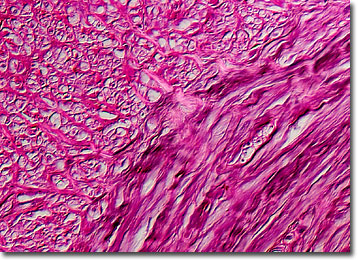Differential Interference Contrast Image Gallery
Vas Deferens Thin Section
The vas deferens, sometimes alternatively referred to as ductus deferens, exists in pairs and is part of the male reproductive system in humans and other mammals. The thick walled-tubes composed of three layers of smooth muscle transport sperm cells from their storage site in the epididymis to the ampullae attached to the walls of the bladder.

The primary target of most permanent or semi-permanent types of male contraception is the vas deferens. The traditional vasectomy, for instance, involves the severing and sealing of each of the reproductive tubes. The surgical procedure is considered safe, simple, and may be completed by most physicians in less than 15 minutes. However, an even more refined method has been developed. Many doctors now offer a less invasive, no-scalpel method of vasectomy that has helped increase the acceptance of male sterilization in many parts of the world where conventional vasectomies were not highly regarded.
The vas deferens, or rather the absence of the tube, is sometimes a natural cause of sterility in men. A condition known as congenital bilateral absence of the vas deferens (CBAVD) is responsible for approximately two to five percent of cases of male infertility. Techniques are available that assist men with CBAVD to have their own biological children, but testing is advised before such action is taken. A large majority of those suffering from CBAVD have a mutation in at least one of the genes that is associated with cystic fibrosis. Therefore, individuals with CBAVD that use assisted reproductive techniques are more likely to produce a child that exhibits the recessive disorder.
